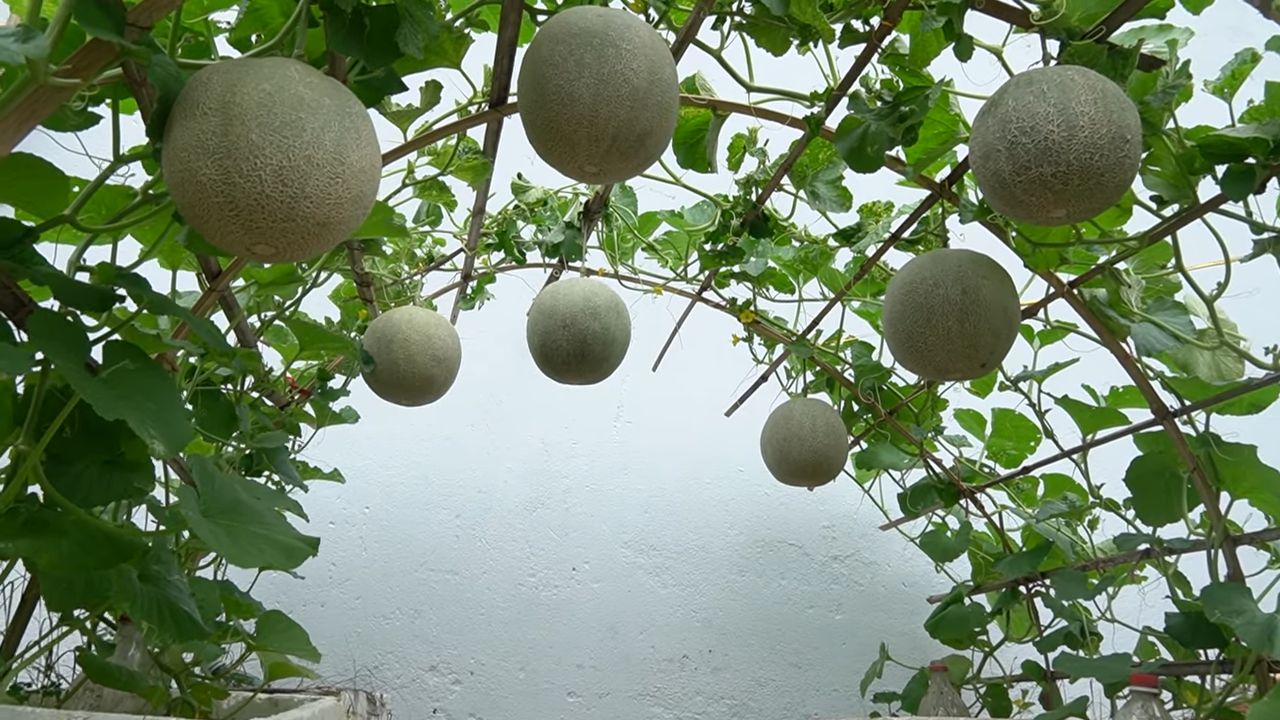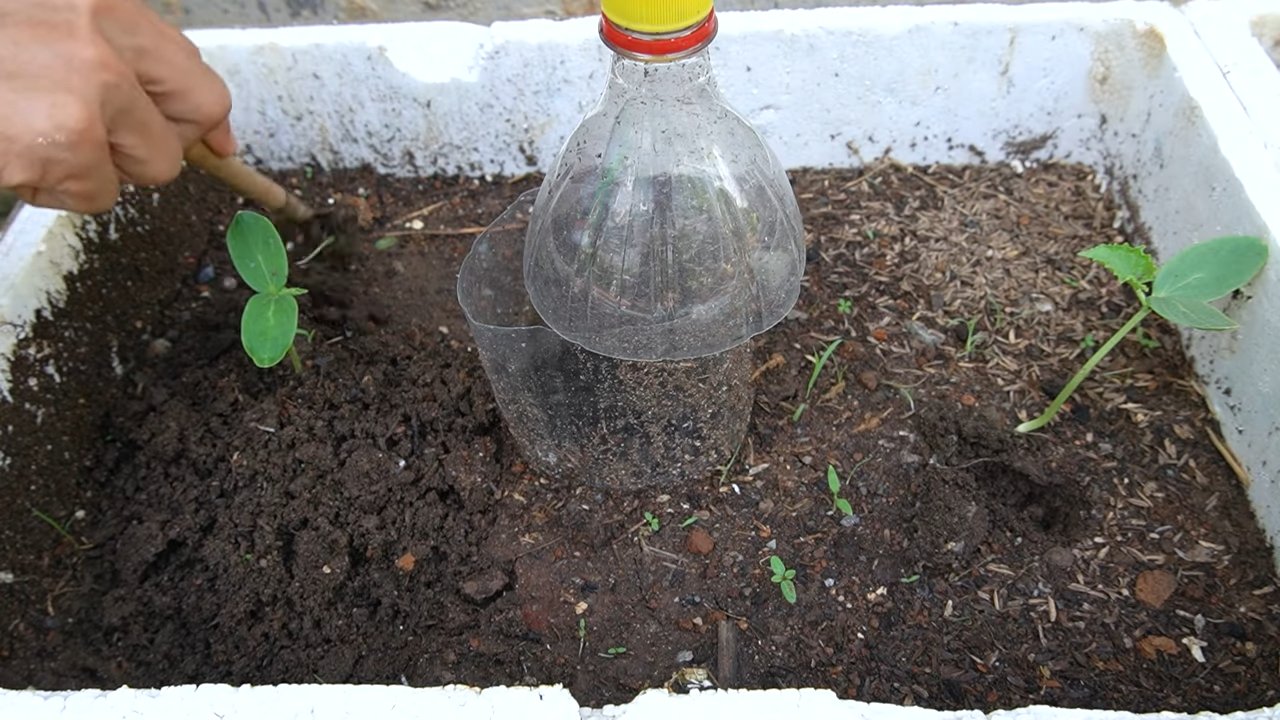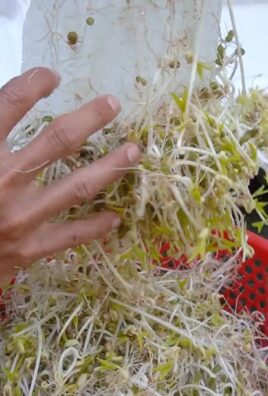Grow Cantaloupe Successfully, even if you think you don’t have a green thumb! Have you ever bitten into a perfectly ripe, juicy cantaloupe and thought, “I wish I could grow these myself?” Well, you absolutely can! For centuries, cantaloupe has been a symbol of summer sweetness, enjoyed by cultures around the world. From ancient Egypt, where they were prized by royalty, to modern-day backyard gardens, this delicious melon has a rich history.
But let’s be honest, growing cantaloupe can seem intimidating. Maybe you’ve tried before and ended up with small, bland fruits, or worse, nothing at all! That’s where these DIY tricks and hacks come in. I’m going to share my tried-and-true secrets to help you grow cantaloupe successfully, right in your own garden.
Imagine harvesting your own sweet, fragrant cantaloupe, knowing you nurtured it from seed to table. No more disappointing grocery store melons! This guide will walk you through everything you need to know, from choosing the right variety to preventing common problems. Get ready to impress your friends and family with your homegrown cantaloupe – let’s get started!

Growing Cantaloupe: A Sweet Success Story (Your Own!)
Okay, so you want to grow cantaloupe? Awesome! I’m here to tell you it’s totally doable, even if you don’t have a sprawling farm. With a little planning and some TLC, you can be enjoying homegrown cantaloupe that tastes a million times better than anything you’ll find in the store. Let’s dive in!
Choosing the Right Cantaloupe Variety
First things first, let’s talk about cantaloupe varieties. Not all cantaloupes are created equal, and some are better suited for certain climates and garden sizes. Here’s a quick rundown of some popular options:
* ‘Athena’: A classic choice, known for its disease resistance and consistent yields. It’s a good all-around option.
* ‘Hales Best Jumbo’: An heirloom variety with a rich, sweet flavor. It takes a bit longer to mature, so keep that in mind if you have a shorter growing season.
* ‘Ambrosia’: This one’s super sweet and juicy! It’s also relatively early-maturing, which is great if you’re impatient like me.
* ‘Minnesota Midget’: Perfect for smaller gardens! These cantaloupes are compact and produce smaller fruits, but they’re still packed with flavor.
* ‘Sugar Cube’: Another great choice for smaller spaces. These are super sweet and mature quickly.
Consider your climate, garden size, and personal taste preferences when making your selection. Seed packets usually have helpful information about each variety’s specific needs.
Preparing Your Garden for Cantaloupe
Cantaloupes are sun-loving, heat-craving plants. They also need well-drained soil that’s rich in organic matter. Here’s how to get your garden ready:
* Sunlight: Choose a spot that gets at least 6-8 hours of direct sunlight per day. This is crucial for fruit development.
* Soil: Cantaloupes thrive in well-drained soil with a pH between 6.0 and 6.8. If your soil is heavy clay, amend it with compost, aged manure, or other organic matter to improve drainage. Sandy soil can be amended with compost to help retain moisture.
* Fertilizer: Cantaloupes are heavy feeders. Before planting, work in a generous amount of compost or aged manure into the soil. You can also add a balanced fertilizer (like 10-10-10) according to the package directions.
* Raised Beds (Optional): If you have poor drainage or just want to give your cantaloupes a head start, consider planting them in raised beds. This will help warm the soil more quickly in the spring.
Starting Cantaloupe Seeds
You have two options here: starting seeds indoors or direct sowing them in the garden. I usually prefer starting seeds indoors because it gives me a head start on the growing season, especially if you live in a colder climate.
Starting Seeds Indoors:
1. Timing: Start your seeds about 3-4 weeks before the last expected frost in your area.
2. Containers: Use seed starting trays or small pots filled with seed starting mix.
3. Sowing: Plant 2-3 seeds per cell or pot, about ½ inch deep.
4. Watering: Keep the soil consistently moist, but not soggy.
5. Warmth: Cantaloupe seeds need warmth to germinate. Use a heat mat or place the trays in a warm location.
6. Light: Once the seedlings emerge, provide them with plenty of light. A sunny windowsill or grow lights will work.
7. Thinning: Once the seedlings have a few true leaves, thin them to one plant per cell or pot. Choose the strongest, healthiest-looking seedling.
8. Hardening Off: Before transplanting the seedlings outdoors, you need to harden them off. This means gradually exposing them to outdoor conditions over a period of 7-10 days. Start by placing them in a sheltered spot for a few hours each day, gradually increasing the amount of time they spend outdoors.
Direct Sowing Seeds:
1. Timing: Wait until the soil has warmed up to at least 65°F (18°C) before direct sowing. This is usually a few weeks after the last expected frost.
2. Planting: Sow seeds about ½ inch deep, spacing them about 2-3 feet apart.
3. Watering: Keep the soil consistently moist until the seedlings emerge.
4. Thinning: Once the seedlings have a few true leaves, thin them to one plant per hill or space.
Transplanting Cantaloupe Seedlings
Whether you started your seeds indoors or bought seedlings from a nursery, transplanting them into the garden is a crucial step.
1. Timing: Transplant your seedlings after the last expected frost and when the soil has warmed up to at least 65°F (18°C).
2. Spacing: Space the plants about 2-3 feet apart in rows that are 4-6 feet apart. This gives them plenty of room to spread out.
3. Planting: Dig a hole that’s slightly larger than the root ball of the seedling. Gently remove the seedling from its container and place it in the hole. Backfill with soil and gently firm it around the base of the plant.
4. Watering: Water the seedlings thoroughly after transplanting.
5. Mulching: Apply a layer of mulch around the plants to help retain moisture, suppress weeds, and keep the soil warm. Straw, hay, or black plastic mulch are all good options.
Caring for Your Cantaloupe Plants
Once your cantaloupe plants are in the ground, it’s time to provide them with the care they need to thrive.
* Watering: Cantaloupes need consistent watering, especially during fruit development. Water deeply and regularly, aiming for about 1-2 inches of water per week. Avoid overhead watering, as this can lead to fungal diseases. Drip irrigation is a great option.
* Fertilizing: Side-dress your cantaloupe plants with a balanced fertilizer every 2-3 weeks. You can also use a liquid fertilizer, such as fish emulsion or seaweed extract.
* Weeding: Keep the area around your cantaloupe plants free of weeds. Weeds compete with the plants for nutrients and water.
* Pest Control: Keep an eye out for common cantaloupe pests, such as aphids, squash bugs, and cucumber beetles. Handpick pests off the plants or use insecticidal soap or neem oil to control them.
* Disease Control: Cantaloupes are susceptible to fungal diseases, such as powdery mildew and downy mildew. To prevent these diseases, provide good air circulation, avoid overhead watering, and apply a fungicide if necessary.
* Pollination: Cantaloupes need to be pollinated in order to produce fruit. Bees are the primary pollinators, so attract them to your garden by planting flowers nearby. If you’re not seeing enough bees, you can hand-pollinate the flowers yourself. To do this, use a small paintbrush to transfer pollen from the male flowers to the female flowers. Female flowers have a small fruit at the base of the flower, while male flowers do not.
* Support (Optional): If you’re growing cantaloupes on a trellis, you may need to provide support for the fruits as they develop. Use netting or slings to support the fruits and prevent them from falling off the vine.
Harvesting Your Cantaloupe
Harvesting cantaloupe at the right time is key to getting that perfect, sweet flavor. Here’s how to tell when your cantaloupe is ripe:
* Color: The skin of the cantaloupe will change from green to a tan or yellowish color.
* Aroma: A ripe cantaloupe will have a sweet, musky aroma.
* Stem: The stem will begin to crack and separate from the fruit. This is called “slipping.”
* Feel: The blossom end of the cantaloupe will be slightly soft to the touch.
To harvest, gently twist the cantaloupe from the vine. If it’s ripe, it should come off easily. If it doesn’t, it’s not quite ready yet.
Enjoying Your Homegrown Cantaloupe
Congratulations! You’ve successfully grown your own cantaloupe. Now it’s time to enjoy the fruits (literally!) of your labor.
* Storage: Store ripe cantaloupe in the refrigerator for up to a week.
* Serving: Cantaloupe is delicious on its own, but it’s also great in fruit salads, smoothies, and desserts.
* Seed Saving: If you want to save seeds from your cantaloupe for next year, scoop out the seeds

Conclusion
So, there you have it! Mastering the art of growing cantaloupe successfully doesn’t require a green thumb blessed by the garden gods. It’s about understanding the plant’s needs, providing the right environment, and employing a few strategic techniques. This guide has armed you with the knowledge to transform your garden into a cantaloupe haven, bursting with sweet, juicy goodness.
Why is this DIY approach a must-try? Because store-bought cantaloupe simply can’t compare to the flavor and satisfaction of harvesting your own. Imagine biting into a sun-ripened cantaloupe, its sweetness intensified by the knowledge that you nurtured it from seed to fruit. Plus, you control the growing process, ensuring your cantaloupe is free from unwanted pesticides and chemicals. You’re not just growing fruit; you’re cultivating a healthier, more sustainable lifestyle.
But the journey doesn’t end here! Feel free to experiment with different cantaloupe varieties. Try growing ‘Athena’ for its disease resistance, ‘Hales Best Jumbo’ for its classic flavor, or even a smaller, personal-sized variety like ‘Sugar Cube’ if you’re short on space. Consider companion planting with marigolds to deter pests or basil to improve flavor. You can also explore different trellising methods to maximize space and improve air circulation.
Don’t be afraid to get your hands dirty and embrace the learning process. Gardening is all about trial and error, and even experienced gardeners face challenges. The key is to observe your plants, adapt your approach, and celebrate your successes, no matter how small.
We wholeheartedly encourage you to embark on this cantaloupe-growing adventure. The reward of enjoying a homegrown cantaloupe is well worth the effort. And remember, the most important ingredient is patience. These melons need time and care to develop their full flavor and sweetness.
Once you’ve harvested your first cantaloupe, we’d love to hear about your experience! Share your tips, tricks, and triumphs in the comments below. Let’s create a community of cantaloupe enthusiasts, sharing our knowledge and inspiring others to grow their own delicious fruit. Your insights could be invaluable to someone just starting out. So, grab your seeds, prepare your soil, and get ready to experience the joy of growing cantaloupe successfully. Happy gardening!
Frequently Asked Questions (FAQ)
What are the most common problems when growing cantaloupe, and how can I prevent them?
Several issues can plague cantaloupe plants. Powdery mildew, a fungal disease that appears as a white, powdery coating on the leaves, is a frequent culprit. To prevent it, ensure good air circulation by spacing plants adequately and pruning excess foliage. Consider using a fungicide specifically formulated for powdery mildew if the problem persists. Another common issue is vine borers, which can tunnel into the stems and kill the plant. Regularly inspect your plants for signs of vine borer activity, such as small holes in the stems or sawdust-like frass. You can wrap the base of the stems with aluminum foil or netting to deter the moths from laying eggs. Blossom-end rot, characterized by a dark, sunken spot on the bottom of the fruit, is caused by calcium deficiency. Ensure your soil has adequate calcium levels and maintain consistent watering to prevent this problem. Finally, pests like aphids and squash bugs can damage cantaloupe plants. Regularly inspect your plants and use insecticidal soap or neem oil to control these pests.
How much sun does cantaloupe need?
Cantaloupe thrives in full sun, requiring at least 6-8 hours of direct sunlight per day. Insufficient sunlight can lead to weak growth, reduced fruit production, and less flavorful melons. Choose a planting location that receives ample sunlight throughout the day. If you live in a particularly hot climate, some afternoon shade may be beneficial to prevent the plants from overheating.
When is the best time to plant cantaloupe?
The best time to plant cantaloupe is after the last frost when the soil has warmed to at least 60°F (15°C). Cantaloupe is a warm-season crop and is sensitive to cold temperatures. Starting seeds indoors 3-4 weeks before the last frost can give you a head start. Transplant seedlings outdoors once the weather is consistently warm. In warmer climates, you may be able to plant cantaloupe directly in the ground after the last frost.
How often should I water cantaloupe plants?
Cantaloupe plants need consistent watering, especially during fruit development. Water deeply and regularly, aiming to keep the soil consistently moist but not waterlogged. Avoid overhead watering, as this can promote fungal diseases. Drip irrigation or soaker hoses are ideal for delivering water directly to the roots. Reduce watering as the fruits ripen to concentrate the sugars and enhance flavor.
How do I know when a cantaloupe is ripe?
Determining when a cantaloupe is ripe can be tricky, but there are several telltale signs. The most reliable indicator is the stem. A ripe cantaloupe will slip easily from the vine with a gentle tug, leaving a smooth, shallow indentation. This is known as the “full slip” stage. Other signs of ripeness include a fragrant aroma, a change in skin color from green to tan or yellow, and a slight softening of the blossom end. Avoid picking cantaloupe that is still green or has a hard, unyielding rind.
What kind of fertilizer should I use for cantaloupe?
Cantaloupe plants benefit from regular fertilization. Before planting, amend the soil with compost or well-rotted manure to improve fertility and drainage. During the growing season, use a balanced fertilizer with equal amounts of nitrogen, phosphorus, and potassium (e.g., 10-10-10). Avoid over-fertilizing with nitrogen, as this can promote excessive foliage growth at the expense of fruit production. Side-dress the plants with fertilizer every 3-4 weeks, following the instructions on the fertilizer label.
Can I grow cantaloupe in containers?
Yes, you can grow cantaloupe in containers, but you’ll need a large container (at least 20 gallons) with good drainage. Choose a dwarf or bush variety of cantaloupe that is better suited for container growing. Use a high-quality potting mix and provide regular watering and fertilization. Trellising the vines can help save space and improve air circulation.
How can I protect my cantaloupe from pests and diseases organically?
Organic pest and disease control methods are essential for growing healthy cantaloupe without harmful chemicals. Encourage beneficial insects like ladybugs and lacewings to prey on aphids and other pests. Use row covers to protect young plants from pests. Apply insecticidal soap or neem oil to control aphids, squash bugs, and other pests. Practice crop rotation to prevent soilborne diseases. Remove and destroy any diseased plant material to prevent the spread of disease. Ensure good air circulation and avoid overhead watering to minimize fungal problems.
How do I save seeds from my cantaloupe for next year?
Saving seeds from your cantaloupe is a great way to perpetuate your favorite varieties. Choose a ripe, healthy cantaloupe and scoop out the seeds. Rinse the seeds thoroughly to remove any pulp. Spread the seeds on a paper towel to dry completely. Store the dried seeds in an airtight container in a cool, dark, and dry place. Label the container with the variety and date. Cantaloupe seeds can remain viable for several years if stored properly.




Leave a Comment